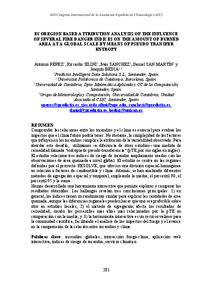Por favor, use este identificador para citar o enlazar este ítem:
http://hdl.handle.net/20.500.11765/16727
Ecoregion based attribution analysis of the influence of several fire danger indices on the amount of burned area at a global scale by means of pseudo transfer entropy
| Título : | Ecoregion based attribution analysis of the influence of several fire danger indices on the amount of burned area at a global scale by means of pseudo transfer entropy |
| Autor : | Pérez, Antonio; Silini, Riccardo; Sánchez, Iván; San-Martín, Daniel; Bedia, Joaquín |
| Palabras clave : | Incendios globales; Interacción fuego-clima; Aplicación web interactiva; Índices de riesgo de incendio; Servicio climático; Global wildfires; Fire-climate interactions; Interactive web application; Fire danger index intercomparison; Climate service |
| Fecha de publicación : | 2025 |
| Editor: | Asociación Española de Climatología; Agencia Estatal de Meteorología |
| Citación : | Luna, M.Y., González-Rouco, F. (Eds.). Cambio climático y sociedad: de la ciencia básica a los servicios climáticos. [Madrid]: Asociación Española de Climatología; Agencia Estatal de Meteorología, 2025, pp. 281-289 |
| Serie/Num. : | Publicaciones de la Asociación Española de Climatología. Serie A;13 |
| Resumen : | [ES] Comprender las relaciones entre los incendios y el clima es esencial para evaluar los
impactos que el clima futuro podría tener. No obstante, la complejidad de los factores
que influyen en los incendios complica la atribución de la variabilidad observada. Para
abordar este desafío, utilizamos –a diferencia de otros estudios– una medida de
causalidad llamada "entropía de pseudo-transferencia" (pTE, por sus siglas en inglés).
El estudio relaciona tres índices de riesgo de incendio ampliamente usados con las
observaciones de área quemada a nivel global. El estudio se centra en las regiones
definidas por el proyecto RESOLVE, que ofrecen una división espacial homogénea
en relación a factores de combustible y clima. Además, se han analizado diferentes
métodos de agregación espacial y temporal, empleando la media, el percentil 90, el
percentil 95 y la suma.
Hemos desarrollado una herramienta interactiva que permite explorar y comparar los
resultados obtenidos. Los hallazgos revelan tres conclusiones principales: 1) en
general, los índices tienen un rendimiento similar para explicar las cantidades de área
quemada, aunque las diferencias regionales pueden hacer que uno sea preferible sobre
otro en estudios locales; 2) el método de agregación afecta los resultados de
causalidad, siendo los percentiles más altos más relacionados por la pTE en
comparación con la media; y 3) la herramienta interactiva es un recurso valioso para
la comunidad científica, facilitando el análisis de los impactos del fuego y el avance
en la comprensión de la relación entre incendios y clima. [EN] Understanding the current fire-climate relationships is of utmost importance in order to assess the potential impacts that projected climate may exert in the near future. However, the many factors involved in fire activity often prevent a proper attribution of the observed variability. Unlike the many previous correlative studies, here we address this problem using a 'causality' measure known as “pseudo transfer entropy” (pTE), relating three widely used fire danger indices to the global observed burned areas. The study has been performed at an spatial aggregation level defined by the RESOLVE ecoregions, attending to their homogeneous fuel and climatic properties, and considering different spatial and temporal aggregation statistics (mean, 90th percentile, 95th percentile and sum). We present an open, web-based interactive tool to explore and compare the results derived from the causality of these different fire danger indices with the observed burned area. Our results unveil some consistent patterns and three main conclusions can be drawn: 1) in the overall, all indices exhibit a similar performance in explaining observed burned areas, although regional differences may justify the selection of one index over another in regional studies, 2) the aggregation method used at the ecoregion level affects the causality results, with higher percentiles being better explained by pTE than the mean state and 3) the interactive tool designed may serve as a valuable method of intercomparison and analysis for the vulnerability and impact assessment community involved in fire research. |
| Descripción : | Ponencia presentada en: XIII Congreso de la Asociación Española de Climatología celebrado en San Lorenzo de El Escorial entre el 22 y el 24 de enero de 2025. |
| URI : | http://hdl.handle.net/20.500.11765/16727 |
| ISBN : | 978-84-125772-3-5 |
| Colecciones: | (2025, San Lorenzo de El Escorial). XIII Congreso AEC (2025, San Lorenzo de El Escorial). XIII Congreso AEC |
Ficheros en este ítem:
| Fichero | Descripción | Tamaño | Formato | ||
|---|---|---|---|---|---|
| XIII_AEC_AntonioPEREZ... | 305,02 kB | Adobe PDF |  Visualizar/Abrir |
Los ítems de Arcimis están protegidos por una Licencia Creative Commons, salvo que se indique lo contrario.





